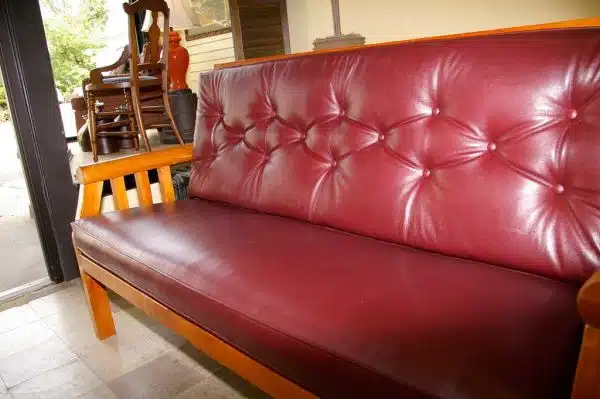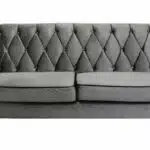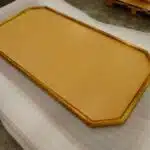When it comes to revamping home decor, sometimes a simple change can make all the difference. Reupholstering a couch is an excellent way to give it a brand new look without having to buy a completely new piece of furniture. This process involves replacing the original fabric with new upholstery while preserving the structure and framework of the sofa. In this article, we will explore how to reupholster a couch step-by-step and provide you with some tips and tricks to ensure a successful transformation.
Reupholstering a couch may seem like an intimidating task, but with the right tools and guidance, it can be a manageable DIY project. Upholstery is an art that requires patience, attention to detail, and precision. It involves working with fabric, foam, padding, springs, webbing, and other materials that make up the foundation of your sofa. By following our guide on how to reupholster a couch, you will not only save money but also gain valuable skills that can be applied to other pieces of furniture in your home or even offered as services for those seeking assistance in this area.
Assessing Your Couch For Reupholstery
As upholstery professionals, we understand the importance of maintaining an aesthetically pleasing home. Your couch is a centerpiece of your living room and has been through years of wear and tear. It may be time to consider reupholstering it to give it a fresh, new look. But before we jump into choosing the right fabric and materials, let’s first assess whether your couch is ready for reupholstery.
Preparing furniture for reupholstery involves more than just picking out a new fabric. You need to ensure that the structure of your couch is sound and sturdy enough to be reupholstered. Check for any loose or broken pieces, especially in areas that receive the most use such as the arms and seat cushions. If there are any issues with the structure, it’s best to address them before starting the reupholstery process.
Choosing fabric is one of the most exciting parts of reupholstering your couch, but it requires careful consideration. Think about your lifestyle and how you use your couch. Do you have pets or children who may cause stains? Are you looking for something durable or do you want something purely decorative? These factors will impact which type of fabric you should choose. In our next section, we will discuss how to choose the right fabric and materials for your reupholstery project.
Choosing The Right Fabric And Materials
When choosing the right fabric and materials for reupholstering your couch, there are several factors to consider. One of the most important factors is fabric durability. When selecting a fabric, it’s crucial to choose one that can withstand everyday wear and tear. Opt for fabrics such as microfiber or leather as they are known for their durability and resistance to stains.
Another factor that should be taken into consideration when choosing upholstery fabric is color coordination. The color of your new upholstery should complement the existing colors in your living space. Choose a color that will blend in seamlessly with the rest of your décor, or go for a bold statement piece if you’re looking to make a statement.
Texture variation is also an important consideration when selecting upholstery fabric. Incorporating contrasting textures can add depth and dimension to your couch, making it both visually appealing and comfortable to sit on. Additionally, cost-effective options such as cotton blends or polyester can be used without sacrificing style or comfort.
When considering all these factors, it’s essential not to overlook the importance of measuring and cutting your new upholstery precisely. By taking precise measurements, you can ensure that you have enough fabric to cover every inch of your couch without any excess material left over. In the next section, we’ll explore some tips for measuring and cutting your new upholstery accurately without wasting any material or time.
Measuring And Cutting Your New Upholstery
For instance, imagine you have found an old couch that has been collecting dust in your attic for years. You decide to bring it back to life and give it a brand new look by reupholstering it. After choosing the right fabric and materials, the next step is to measure and cut your new upholstery.
Measuring tips are crucial in ensuring that you have enough fabric for your project. Before beginning, make sure you have all the necessary tools such as measuring tape, scissors, and a marker. Start by measuring each section of the couch separately – including the arms, cushions, backrests, and seat. Be precise when taking measurements as any errors could result in ill-fitting upholstery.
Once you have taken accurate measurements of your old upholstery pieces, it’s time to move on to cutting techniques. It’s essential to be careful when cutting as one wrong move could lead to wastage or improper fitting of the new fabric. Use sharp scissors or a rotary cutter for precise cuts along straight lines. For curved sections like arms or cushions with rounded edges, use small snips until they fit perfectly into place. With these measurement and cutting tips in mind, you can now move on to removing the old upholstery and padding without causing any damage to your furniture piece.
Removing The Old Upholstery And Padding
To begin the process of reupholstering your couch, one of the first steps is to remove the old upholstery and padding. This may seem like a daunting task, but with proper preparation and tools, it can be done with ease. The first step is to locate all the staples holding the fabric in place. You can use a staple remover or pliers to pull them out. It’s important to note that some staples may be hidden under folds or welting, so make sure to check thoroughly.
After removing all the staples, it’s time to take out the old foam padding. If it’s still in good condition, you can reuse it; otherwise, it will need to be replaced. To remove the foam from your couch, start at one end and gently pull until it comes loose. Be careful not to tear the foam as this will affect its ability to cushion properly.
Once you’ve removed both the old upholstery and padding, take a moment to inspect your couch’s frame and springs for any damage that may need repairing or replacing. This is an essential step in ensuring your sofa lasts for years to come. If you notice any broken or weak areas, now is the time to address them before moving on with your reupholstering project. By taking care of these repairs early on in the process, you’ll save yourself time and money down the line by avoiding having to redo sections of your newly upholstered sofa.
Repairing Or Replacing The Frame And Springs
- A thorough examination of the frame is the first step in repairing or replacing the frame and springs of a couch.
- Springs should be replaced if they are loose, broken, or worn out.
- Damage to the frame should be repaired before any new upholstery is applied.
- A professional upholsterer should be consulted to diagnose any issues with the frame or springs.
- Repairs to the frame should be made with durable materials to ensure a long-lasting result.
- Replacing the springs should be done carefully to ensure a supportive, comfortable result.
Examining The Frame
To properly reupholster a couch, it is essential to examine the frame before proceeding with any repairs or replacements. Examining the frame allows you to identify any weak or damaged areas that may require reinforcing joints or other corrective measures. It also enables you to determine whether refinishing wood is necessary to restore the frame’s aesthetic appeal.
Firstly, begin by inspecting the joints of the frame for looseness or damage. Reinforcing joints can be done by applying glue and clamping them until they dry. Additionally, adding brackets or screws at weak points helps strengthen the structure. After reinforcing the joints, proceed to examine each piece of wood for cracks, chips, and scratches. Refinishing wood involves sanding down rough areas and applying paint or stain for a smooth finish.
Lastly, evaluate the springs within the frame to ensure they provide adequate support for comfortable seating. Replace any worn-out springs that cause discomfort when sitting on the couch. Failure to address weak springs may result in further damage to other parts of the couch such as cushions and fabric covers. By examining and repairing or replacing damaged parts of your couch’s frame before reupholstering it, you can prolong its lifespan and give it a brand new look without compromising on comfortability.
Replacing Springs
After examining the frame, the next step in reupholstering a couch involves assessing the condition of the springs. The springs are an integral part of the couch’s structure, providing support for comfortable seating. There are various types of springs commonly used in couches, including coil springs and sinuous springs. Coil springs are typically more expensive than sinuous springs but offer greater durability and support.
When replacing worn-out or damaged springs, it is essential to consider both the cost and quality of the replacement options available. Replacing all the springs at once may be costly, but it ensures uniformity and consistency in your couch’s level of comfort. However, if you choose to replace only a few faulty springs, ensure they match the existing ones’ size and tension to prevent unevenness.
In summary, replacing worn-out or damaged springs is crucial when repairing or replacing a couch’s frame before reupholstering it. It is necessary to evaluate both the type and cost of replacement options available while ensuring uniformity in spring size and tension for consistent comfort levels. By taking these steps, you can restore your couch’s structural integrity and prolong its lifespan while achieving an updated look with new upholstery.
Repairing Damage
After assessing the condition of the frame and springs, the next step in reupholstering a couch involves repairing any damage that may have occurred. Common issues include tears, rips, stains, and holes. Repairing tears and fixing rips often involves sewing or patching the affected area with matching fabric. Dealing with stains requires identifying the type of stain and using appropriate cleaning methods to avoid damaging the upholstery further. Patching holes can be done by either adding a new piece of fabric or filling it with upholstery foam.
When repairing damage to a couch’s upholstery, it is essential to take extra care not to cause additional harm. This means using suitable materials and techniques for each specific repair needed. For instance, using an incorrect thread color or weight when sewing a tear can lead to visible stitching that ruins the overall look of the couch. Similarly, using harsh chemicals when cleaning stains can cause discoloration or fading.
In conclusion, repairing damage is a critical step in reupholstering a couch after examining its frame and springs. By taking care to use appropriate materials and techniques, you can achieve a durable repair that improves both comfort and aesthetics. Whether you are dealing with tears, rips, stains, or holes, there are solutions available that will help restore your couch’s appearance while prolonging its lifespan.
Securing The New Webbing And Padding
As we continue to reupholster your couch, it is essential to secure the new webbing and padding correctly. Doing so will ensure that the sofa has a sturdy base and is comfortable to sit on. In this section, we will discuss the best webbing techniques and padding materials.
Firstly, when securing new webbing, it’s important to use a crisscross pattern to evenly distribute weight across the frame. This technique also ensures that any potential sagging is prevented. To get started, attach one end of the webbing to the front of the frame and stretch it tightly towards the back. Once you’ve reached the desired tension point, staple or tack it down before repeating the process in a perpendicular direction.
Secondly, selecting suitable padding materials is crucial for achieving comfort in your newly upholstered couch. While foam is often used for padding sofas today, there are other options available. Horsehair filling may be used for a more traditional look while still providing sufficient support. Alternatively, cotton batting can be used as a top layer over foam or horsehair filling for added softness.
Now that you have secured your new webbing and chosen appropriate padding materials for your sofa, it’s time to move onto attaching the new upholstery to the frame. But before we dive into that step, let’s take a moment to appreciate how far along you’ve come in this reupholstering journey!
Attaching The New Upholstery To The Frame
- Before attaching the new upholstery to the frame, one must accurately measure the fabric so that it fits the frame perfectly.
- To ensure the fabric is properly stretched and secured, it is important to prepare the frame beforehand by removing the existing upholstery and any staples.
- To attach the new upholstery, one must use the correct tools such as a staple gun, pliers, and scissors.
- Additionally, it is important to use a strong adhesive to ensure that the upholstery is attached securely to the frame.
Measuring Fabric
To give your old couch a brand new look, reupholstering it is a great option. Measuring fabric is a crucial step in this process. Choosing the right amount of fabric will ensure that you have enough to cover the entire couch without having any excess. Cutting techniques are also important to consider as they can affect the overall appearance of the finished product.
Before measuring your couch for new upholstery, remove all existing fabric and padding. This will allow you to see the exact dimensions of the frame and determine how much fabric you will need. When choosing fabric, consider the type of material you want and its durability. Be sure to purchase enough fabric to cover the entire couch, including any cushions or armrests.
When cutting your chosen fabric, use sharp scissors or a rotary cutter for precision. Measure twice before making any cuts to avoid wasting material. Consider adding extra inches around each piece of fabric for seam allowances and tucking into corners properly. Proper measuring and cutting techniques are essential for achieving a professional-looking reupholstered couch that is both comfortable and aesthetically pleasing.
In conclusion, measuring fabric is an important step when reupholstering a couch. Choosing the right amount of material and using proper cutting techniques can make all the difference in achieving a polished end result. With patience and attention to detail, anyone can successfully reupholster their old couch and give it new life.
Preparing The Frame
Now that the fabric has been measured and cut, it is time to prepare the frame for attaching the new upholstery. Before doing so, it is important to ensure that the frame is in good condition. This includes sanding and cleaning any rough or dirty areas, as well as reinforcing and strengthening weak spots. By taking these steps, you will not only improve the overall appearance of the couch but also increase its lifespan.
Sanding and cleaning the frame is an essential step in preparing it for reupholstering. This involves removing any rough edges or splinters with sandpaper and wiping down the entire frame with a clean cloth to remove dirt and dust. By doing so, you create a smooth surface for attaching new upholstery, which will result in a more polished end product.
In addition to sanding and cleaning, reinforcing and strengthening weak spots in the frame is crucial for ensuring that your reupholstered couch lasts as long as possible. This can be done by adding extra wood supports or metal brackets where needed. By taking these steps before attaching new upholstery, you will not only improve the structural integrity of the couch but also provide a more comfortable seating experience for those who use it.
Creating A Professional-Looking Finish
Congratulations on successfully reupholstering your couch! Now, it’s time to focus on creating a professional-looking finish. The right finishing techniques can make all the difference in achieving a polished and high-quality appearance.
One of the most important things to consider is the color of your upholstery. Trends come and go, but it’s important to choose a color that you love and that complements your space. Don’t be afraid to mix and match colors or patterns for a unique look. Remember that the finishing touches can really elevate the overall aesthetic of your piece.
When it comes to DIY finishing techniques, there are several options available. One popular technique is using piping or welting to create clean lines and add visual interest. Another option is utilizing decorative nailhead trim or tufting for added texture and depth. Ultimately, the key is to choose techniques that complement your design style and skill level.
In the next section, we will explore how adding decorative accents and details can enhance the overall look of your newly upholstered couch. But before we move on, remember that creating a professional-looking finish requires attention to detail and patience. Take your time with each step, and don’t be afraid to experiment with different techniques until you achieve the perfect result.
Adding Decorative Accents And Details
After completing the professional-looking finish on your reupholstered couch, it’s time to add some unique trimmings and embellishments to give it a personalized touch. This step can really make all the difference in transforming your old couch into a brand new piece of furniture. Adding decorative accents is also an opportunity to showcase your creativity and style.
Firstly, consider the fabric you have used on the couch and choose trimmings that complement or contrast with it. For example, if you’ve used a neutral fabric like beige or gray, bright-colored trims like red or blue would create an interesting contrast. If you’ve used a patterned fabric, choose solid-colored trims that match one of the colors in the pattern. Some popular choices for trimmings include piping, fringes, tassels, and braids.
Secondly, think about adding unique embellishments to your reupholstered couch such as buttons or studs. These can be added to the seat cushions or backrest for an eye-catching effect. You can also use contrasting fabrics to create appliques or embroidery designs on your couch.
Lastly, keep in mind that less is more when it comes to adding embellishments and trimmings. Don’t overdo it by adding too many different elements at once. Choose one or two focal points and stick with them for a cohesive look.
Adding embellishments and unique trimmings is a fun way to personalize your newly reupholstered couch. By carefully selecting these elements based on your fabric choice and using them sparingly, you can create a stunning piece of furniture that reflects your personal style. In the next section, we’ll discuss how to maintain your newly reupholstered couch so that it stays looking fresh and new for years to come.
Maintaining Your Newly Reupholstered Couch
Like a newborn baby, your newly reupholstered couch requires proper care and maintenance to keep it looking fresh and new. The right cleaning techniques will ensure that your couch stays clean and free from stains, while the right pillows can add both comfort and style to your space.
To keep your couch looking its best, make sure to vacuum it regularly with a soft brush attachment. This will help remove any surface dirt or debris that may have accumulated over time. For tougher stains, use a mild detergent mixed with warm water and gently blot the affected area with a clean cloth. Avoid using harsh chemicals or scrubbing too hard, as this can damage the fabric.
In addition to regular cleaning, choosing the right pillows can also make a big difference in the overall look and feel of your couch. Consider selecting pillows that complement the color scheme of your room or add an interesting texture or pattern. With these tips in mind, you’ll be able to maintain your newly reupholstered couch for years to come. Moving forward, let’s discuss some important safety precautions to consider when embarking on DIY upholstery projects.
Safety Precautions For Diy Upholstery Projects
When embarking on a DIY upholstery project, it is important to prioritize safety. Upholstery can be a hazardous activity that poses several risks if proper precautions are not taken. To ensure your safety and the success of your project, consider the following DIY upholstery safety tips and hazard prevention measures.
Firstly, make sure you have all the necessary tools and equipment required for the job. This includes gloves, protective eyewear, and a mask to prevent inhalation of harmful dust particles. Additionally, ensure that all electrical tools are in good working condition and that cords are not frayed or damaged. When using sharp objects such as scissors or staple guns, use them with caution to avoid accidental injuries.
Another essential safety measure is to work in a well-ventilated area. This will minimize exposure to potentially dangerous fumes from adhesives or chemicals used during the process. If possible, set up your workspace near an open window or door to increase airflow.
To summarize, DIY upholstery safety is crucial when undertaking any upholstery project. By taking adequate precautions such as wearing protective gear, ensuring equipment is in good working condition, and working in a well-ventilated area, you can minimize potential hazards and complete your project safely.
- Protecting yourself during DIY upholstery projects may take time but will save you from accidents.
- Safety should be given top priority before starting any kind of DIY Upholstery work.
- Always ensure you have all the right protective tools and equipment before commencing any Upholstery work at home.
With these safety tips in mind, let’s move on to common mistakes to avoid when reupholstering your couch for optimal results.
Common Mistakes To Avoid
Ensuring safety precautions when embarking on DIY upholstery projects is crucial. In the previous section, we highlighted some of the vital measures to consider before starting a reupholstery project. The next step is to avoid common mistakes that can compromise the quality of your work.
One common mistake that most people make is cutting corners. Upholstery requires precision and attention to detail, and taking shortcuts may compromise the final outcome. For instance, using low-quality fabric or stuffing may save you some money in the short term, but it will not last long, and you will end up spending more money in the long run.
Another common mistake is rushing the process. Upholstery takes time, and it is essential to take your time to ensure that everything is done correctly. Rushing through different stages of upholstery can lead to crooked seams or uneven stuffing, which can be unsightly and uncomfortable. Therefore, ensure that you have enough time set aside for each stage of upholstery to ensure quality workmanship.
In summary, avoiding these two common mistakes – cutting corners and rushing through the process – can help you achieve excellent results with your DIY upholstery project. In our next section, we will provide tips for working with difficult fabrics that require extra care during reupholstery projects.
Tips For Working With Difficult Fabrics
- When selecting the right fabric for reupholstering a couch, it is important to consider the fabric’s durability and performance, as well as its aesthetic appeal.
- Working with thick fabrics can be challenging, so it is important to use the correct tools, such as heavy-duty scissors, and to take extra care when cutting and manipulating the fabric.
- It is also important to use appropriate upholstery techniques when reupholstering with thick fabrics, such as making sure to have ample padding, as this will help to distribute the weight of the fabric and reduce stress on seams.
- In addition, it is important to use a strong thread when sewing thick fabrics and to use a higher stitch count to ensure a secure seam.
Selecting The Right Fabric
Selecting the right fabric for reupholstering a couch is an important task that should not be taken lightly. It involves choosing colors and finding patterns that will complement the overall design of the room where the couch will be placed. As an upholstery professional, I recommend that you take your time in selecting the perfect fabric for your project.
When choosing colors, it’s important to consider the existing color scheme of your room. You don’t want to choose a fabric that clashes or overwhelms other elements in the space. Instead, look for colors that complement or contrast with your current decor. Additionally, keep in mind that lighter fabrics tend to show stains and wear more easily than darker ones.
Finding patterns can also be a daunting task, but it’s essential for creating a cohesive look in your space. Consider the scale of the pattern and how it will look when applied to a larger surface like a couch. Small-scale patterns may get lost on a large piece of furniture, while larger-scale patterns can overpower the room if not balanced correctly. Ultimately, you want to choose a pattern that adds interest without overwhelming the rest of your design elements.
In summary, selecting the right fabric is crucial when reupholstering a couch as it impacts both form and function in your space. Take into account existing color schemes and patterns when making choices about fabrics to ensure that you create harmony and balance within your design scheme. Remember to take your time during this process so as to select only what best suits your needs and preferences as well as meets industry standards for excellence.
Working With Thick Fabrics
When reupholstering furniture, working with thick fabrics can pose a unique set of challenges for DIY enthusiasts. The thickness of the fabric can make it difficult to manipulate and may require special tools or techniques to ensure a successful outcome. However, with some creative solutions and proper guidance, working with thick fabrics can be accomplished.
One of the biggest challenges when working with thick fabrics is ensuring that the fabric lays flat and does not bunch or pucker. This can be achieved by using a heavy-duty sewing machine that has the power to handle thicker fabrics. Additionally, upholstery professionals recommend using specialized upholstery needles that are designed for heavier fabrics. Another solution is to use a walking foot attachment on your sewing machine to ensure that both layers of fabric move through the machine at the same speed.
When working with thick fabrics, it’s also important to have the right DIY upholstery tools on hand. These may include pliers for pulling needles through tough layers of fabric, staple removers for removing old staples from furniture frames, and webbing stretchers for securing new webbing in place. Having these tools readily available will make the process smoother and more efficient. In conclusion, while working with thick fabrics presents its own set of unique challenges, proper preparation and utilizing industry-standard techniques and tools can lead to success in any DIY upholstery project.
When To Consider Professional Reupholstery Services
When it comes to reupholstering a couch, there are two options available: DIY or professional services. While DIY may seem like the more cost-effective choice, it is essential to consider the level of skill required for this task. Upholstery requires not only sewing skills but also knowledge of fabrics and furniture construction. Without proper training, a DIY project can quickly turn into a costly and time-consuming disaster.
Cost considerations are also crucial when deciding whether to reupholster a couch yourself or hire professionals. While the initial cost of materials for a DIY project may be lower than hiring professionals, it is essential to factor in potential mistakes that can lead to extra expenses. In contrast, professional upholstery services typically come with guarantees and warranties that ensure quality workmanship and material durability.
If you are unsure about your ability to complete a reupholstery project successfully or do not have the necessary tools, it is best to consider hiring professional services. They have the expertise and experience needed to handle any unforeseen issues that may arise during the upholstery process. Opting for professional services will save you time, money, and stress in the long run.
As previously mentioned, reupholstering furniture requires skills and knowledge beyond basic sewing abilities. However, suppose you are still interested in revamping your furniture without professional assistance. In that case, there are other DIY ideas worth exploring such as painting or refinishing wooden frames or adding decorative elements like throw pillows or blankets to give your couch a brand new look at an affordable cost.
Other Diy Furniture Revamp Ideas
When considering ways to revamp furniture, reupholstering a couch is a popular option. However, there are other DIY ideas that can give your furniture a new look without having to hire professional services. Upcycling furniture is a trend that has gained popularity in recent years, and it involves repurposing old items to create something new.
One creative decor idea is to paint your furniture with bold colors or patterns. This can add personality and uniqueness to your pieces, giving them an entirely new vibe. Another way to revamp furniture is by adding wallpaper or fabric accents to drawers or tabletops. This not only adds visual interest but also protects the surface from scratches.
Incorporating sustainable materials into furniture revamps is another growing trend. Consider using reclaimed wood or metal for table legs, or repurposing old textiles into throw pillows or seat cushions. By incorporating these eco-friendly elements, you can give your furniture a new life while reducing waste and contributing to environmental sustainability.
Upcycling furniture and exploring creative decor ideas can be a fun and rewarding way to give your belongings a fresh look without breaking the bank. With these tips in mind, you can transform any piece of furniture into something unique and personalized that reflects your style and values.
Conclusion
When it comes to reupholstering your couch, there are several steps you need to take in order to ensure a successful and long-lasting result. First, assess the condition of your couch and determine if it is worth the investment of time and money. Next, choose the right fabric and materials for your project, taking into consideration factors such as durability and style.
Once you have your materials, measuring and cutting your new upholstery is crucial for a precise fit. Removing the old upholstery and padding can be a messy process, but it is necessary in order to repair or replace any damaged areas of the frame or springs. Avoid common mistakes such as rushing through the process or using inappropriate tools.
Working with difficult fabrics can also pose a challenge, but with some tips and patience, you can achieve a professional-looking result. However, if you feel overwhelmed or unsure about tackling this project on your own, consider hiring a professional reupholstery service.
In conclusion, reupholstering your couch can give it a brand new look and extend its lifespan. With careful planning, attention to detail, and patience, you can revamp not only your couch but also other furniture pieces in your home. As an upholstery professional/instructor would say: “Remember that every stitch counts and each cut must be precise in order to create a beautiful masterpiece.”
Image Credits
- “Leather Danish-style couch” by Upholstery and much more! (featured)





























